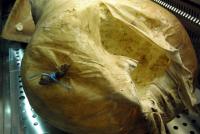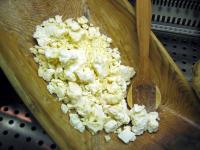Sack Cheese (Sir iz Mijeha) from the Nevesinje region
It is the container itself, the sack, which makes this product so unique. The cheese is put in a light brown sack of sheepskin, turned inside out, and weighs 30-70 kilos depending on the size of the animals. Sack cheese is made in certain villages of Nevesinje, a harsh and mountainous region in southeastern Bosnia and Herzegovina and the grazing land for the local Pramenka sheep (used for milk, meat and wool). Sir iz Mijeha is produced with top quality raw milk from sheep or cows, or a combination of the two, depending on availability. The sheep milk comes from the Pramenka sheep. The portion of cow milk comes from two native breeds the Busa and the Gatacka (now on the decline however).

Shortly after the milking, it is filtered through cheesecloth and immediately processed. Coagulation takes about an hour and a half after the rennet is added and the curd settles at the bottom. Using a large ladle, the curd is broken into walnut-sized lumps to facilitate the draining of whey. The mass of curds are then placed on a cloth and pressed with a stone for about 12 hours. Later, the curd is broken again by hand, salted and packed into the sheepskin using a stick (the curds must pressed into the bottom of the sack to avoid forming air pockets, which results in undesirable fermentation). It takes many days to fill a sack since such a large quantity of high quality milk is required. Once filled, the sack is sealed shut and placed in a cool place suitable for aging. The aging period varies between two and three months. To prepare the sack they need to butcher the sheep without damaging the skin, then shave it and wash it with boiling water and whey. When dry, they tie the legs and neck, fill the sheep with air and hang it to dry in a place where meat is usually smoked. It is then washed a second time and left to dry in the open air.

The cheese becomes white or slightly yellowish once aged. In Herzegovina, it is traditionally served as an appetizer, with boiled potatoes or with ham and ustipici (fried dumplings).
The Presidium was founded in collaboration with the Italian Province of Arezzo and Ucodep, an Italian NGO operating in Bosnia and Herzegovina to promote certain local products. Its aim is to protect the indigenous breeds involved and to help the fifteen or so producers to work in accordance with the law and to sell, at least at a local level. It will also draw up a regulatory framework for production. By promoting the Sir iz Mijeha, the presidium hopes to safeguard the native farm animal diversity: the Pramenka sheep and the Busa and the Gatacka cattle.
The cheese is currently produced in three ways: with cows milk (in winter), with sheeps milk (in summer) and with a mixture of both.
The producers of the Sack Cheese (Sir iz Mijeha) from the Nevesinje region are member of the Terra Madre network with 1.600 small food communities in 150 countries and belongs to the group of 300 food communities, which are also presidia. Projects launched by the Slow Food Foundation for Biodiversity to support small producers (farmers, breeders, fishermen, cheesemakers, and so on) and to support products in danger of extinction.
Production area
Nevesinje region
Community coordinator
Slavica Samardzic
tel. ++387 (0)65 750 427
slavica92000@yahoo.com
Presidium supported by
Ucodep, Italy